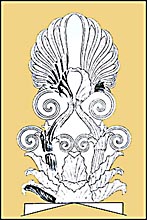By 'architectural sculpture' we mean sculptures,
whether in relief or in the round, that serve to
embellish buildings (chiefly public buildings). Most of
our surviving specimens come from temples. Architectural
sculptures proper occur as pediment compositions,
finials, and either metope-panel or frieze reliefs
(depending on whether a building belongs to the Doric or
the Ionic order). There are other parts of a building
which can have pictorial sculptures on them: for example
columns, base walls and protective parapets (thorakion). It is normally on a
building of the Ionic order that these special features
appear. Besides pictorial sculptures there are a large
number of decorative motifs with their position
often determined by their architectural order. |
 |
Architectural sculptures usually carried clear indications of
the use they were intended for. They envisaged a bottom-up
perspective, since the viewer was standing below them. Details
that could not be seen from a distance were not given elaborate
attention; surfaces that were never going to be visible were left
unworked; and the background was painted in colour (so as
to point up the outline of the figures), as were the hair, eyes,
lips and clothing, so as to make them more conspicuous.
The decorative sculptures of
the Parthenon - metope-panels, frieze, and pediment
compositions - are in every way a special case. From other public
buildings in Athens and Attica portions of mid-5th
century architectural sculptures
have survived. Unhappily, most are very badly damaged. We have
almost no information about the architectural sculpture of the 4th century B.C..




